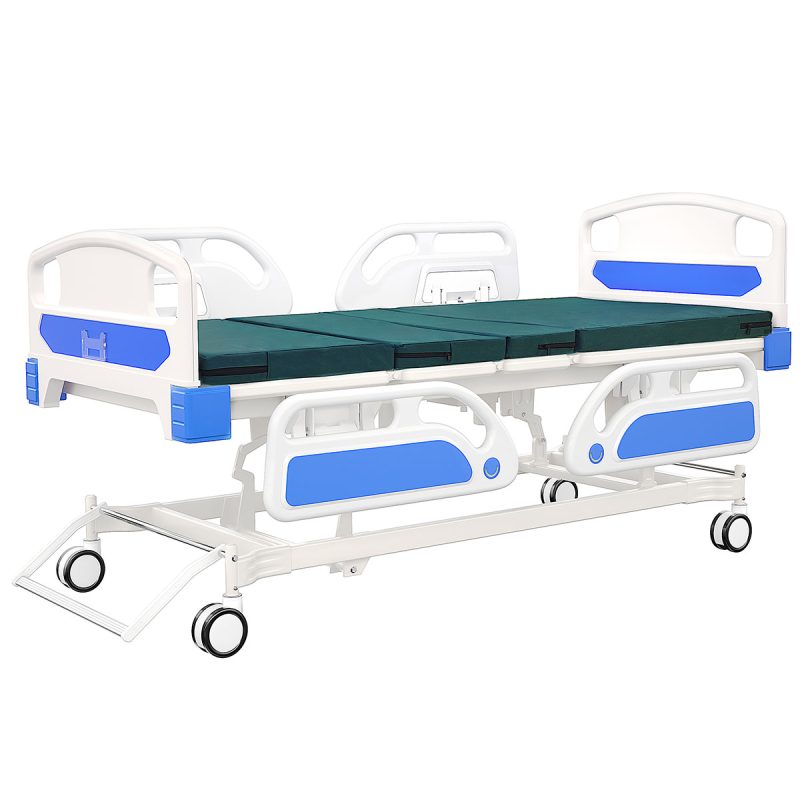Yes, hospital beds come in different sizes to accommodate the diverse needs of patients. Standard hospital beds typically measure 36 inches wide and 80 inches long, suitable for most adults. However, for patients requiring more space or support, larger options such as full-size beds (54 inches wide) and bariatric beds (up to 48 inches wide and 88 inches long) are available. Bariatric beds are specifically designed for overweight or obese patients, providing enhanced support and safety with higher weight capacities. Pediatric hospital beds are smaller and include additional safety features tailored for children. Additionally, hospital beds often come with adjustable features, allowing for modifications in height, head, and foot sections to meet various medical needs. Adjustable height beds aid in patient transfers and caregiving tasks, reducing injury risks. Electric beds offer convenient adjustments via buttons, while manual beds require physical adjustments using cranks. Intensive Care Unit (ICU) beds are equipped with advanced functionalities like built-in scales and cardiac chair positioning for critical care. The variety in hospital bed sizes and features ensures that healthcare providers can offer personalized and effective care, enhancing patient comfort and safety. Hospitals select bed sizes based on the patient’s medical condition, body size, and care requirements, aiming to provide the best possible support during their hospital stay.
Standard Sizes of Hospital Beds
- Twin and Full Sizes:
- Twin Size: The most common size for hospital beds is the twin size, which typically measures 36 inches wide and 80 inches long. This size is generally sufficient for most adult patients and allows for ease of maneuverability within a hospital room.
- Full Size: Some hospitals also use full-size beds, which are wider, usually around 54 inches. These are often used for patients who require more space, such as those with larger body sizes or those who need more room for movement and repositioning.
- Bariatric Beds:
- Bariatric hospital beds are designed for patients who are overweight or obese. These beds are larger and sturdier, often measuring up to 48 inches wide and 88 inches long. They are built to support higher weight capacities, sometimes up to 1,000 pounds or more, ensuring the safety and comfort of bariatric patients.
- Pediatric Beds:
- Pediatric hospital beds are specifically designed for children. These beds are smaller and often come with additional safety features such as side rails and adjustable heights to prevent falls and ensure the child’s comfort and security.
Adjustable and Specialty Beds
In addition to the standard sizes, hospital beds often come with adjustable features to accommodate various medical needs. These include:
- Adjustable Height Beds: These beds can be raised or lowered to assist with patient transfers and caregiving tasks. They help reduce the risk of injury to both patients and healthcare providers.
- Electric and Manual Beds: Electric beds offer convenient adjustment options at the push of a button, while manual beds require physical adjustments using cranks. Both types provide options for adjusting the bed’s height, head, and foot sections.
- ICU Beds: Intensive Care Unit (ICU) beds are equipped with advanced features such as built-in scales, cardiac chair positioning, and various monitoring devices. They are often wider and longer to accommodate critical care needs.
Related Questions
- Why is the variety in hospital bed sizes important?
- The variety in hospital bed sizes is crucial to accommodate the diverse needs of patients. Different medical conditions and body types require specific bed dimensions and features to ensure patient comfort, safety, and effective medical care. For instance, bariatric patients need larger, sturdier beds, while pediatric patients require smaller beds with enhanced safety features.
- How do hospitals choose the right bed size for a patient?
- Hospitals assess several factors when choosing the right bed size for a patient. These factors include the patient’s medical condition, body size, mobility requirements, and the type of care they need. Healthcare providers also consider the room size and the need for additional medical equipment around the bed.
- Are hospital bed sizes standardized across all hospitals?
- While there are common standard sizes for hospital beds, the availability and usage of different sizes can vary across hospitals. Factors such as the hospital’s patient demographics, specialty services, and budget can influence the variety of bed sizes they have. However, hospitals generally strive to have a range of bed sizes to meet the diverse needs of their patients.
In conclusion, hospital beds come in various sizes and configurations to cater to the specific needs of patients. The availability of different bed sizes ensures that healthcare providers can deliver personalized and effective care, enhancing patient comfort and safety during their stay in the hospital.
If you are considering purchasing a hospital bed, please visit the official website of epachois,here:https://www.epachois.com/


